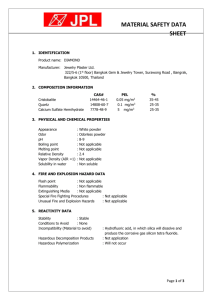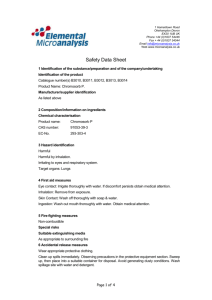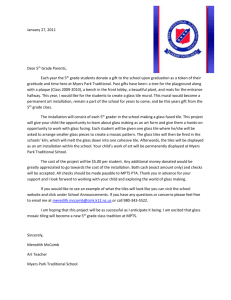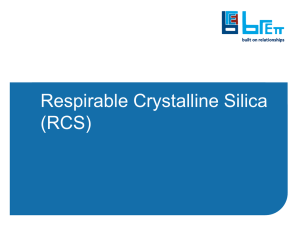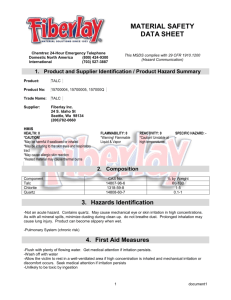The MSDS - Hirsch Glass Corp
advertisement
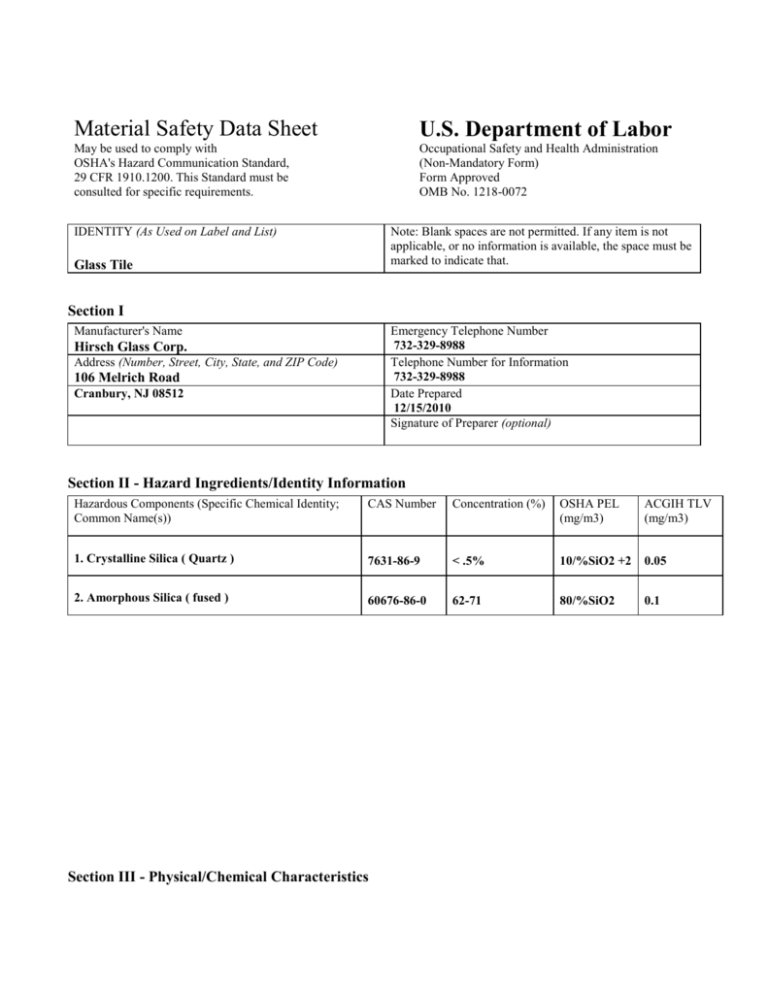
Material Safety Data Sheet U.S. Department of Labor May be used to comply with OSHA's Hazard Communication Standard, 29 CFR 1910.1200. This Standard must be consulted for specific requirements. Occupational Safety and Health Administration (Non-Mandatory Form) Form Approved OMB No. 1218-0072 IDENTITY (As Used on Label and List) Note: Blank spaces are not permitted. If any item is not applicable, or no information is available, the space must be marked to indicate that. Glass Tile Section I Manufacturer's Name Emergency Telephone Number 732-329-8988 Telephone Number for Information 732-329-8988 Date Prepared 12/15/2010 Signature of Preparer (optional) Hirsch Glass Corp. Address (Number, Street, City, State, and ZIP Code) 106 Melrich Road Cranbury, NJ 08512 Section II - Hazard Ingredients/Identity Information Hazardous Components (Specific Chemical Identity; Common Name(s)) CAS Number Concentration (%) OSHA PEL (mg/m3) ACGIH TLV (mg/m3) 1. Crystalline Silica ( Quartz ) 7631-86-9 < .5% 10/%SiO2 +2 0.05 2. Amorphous Silica ( fused ) 60676-86-0 62-71 80/%SiO2 0.1 Section III - Physical/Chemical Characteristics Boiling Point ( Specify oF or oC ) Not Applicable Specific Gravity (H2O = 1) Vapor Pressure (mm Hg.) Not Applicable Melting Point > 2000 o F Vapor Density (AIR = 1) Not Applicable Evaporation Rate (Butyl Acetate = 1) Not Applicable Solubility in Water Insoluble 1.75 – 2.93 Appearance And Odor Brittle solid; color may vary and Odorless Section IV - Fire and Explosion Hazard Data Flash Point (Method Used) Not Applicable Extinguishing Media None Required. Non-Flammable Special Fire Fighting Procedures None Required Unusual Fire and Explosion Hazards None Required Flammable Limits LEL Not Applicable UEL Not Applicable Section VI - Health Hazard Data Route(s) of Entry: Inhalation? Yes Skin? Yes Ingestion? No Health Hazards (Acute and Chronic) Acute – Excessive exposure to tile dust can cause eye, skin and lung irritation from mechanical abrasion. Ingestion is not applicable for intact tile. Chronic – Not Applicable for intact tiles. Excessive exposure to tile dust can cause discomfort and mechanical irritation. Long term exposure to silica dusts can lead to silicosis. Carcinogenicity – Respirable crystalline silica (quartz) is classified by International Agency for Research on Cancer (IARC) as a human carcinogen. Intact tile is not believed to be hazardous and limited potential of exposure exists for crystalline silica (quartz) during installation, disposal and/or if damaged. Crystalline silica is described in ACGIH and NIOSH as being identified in other sources as a suspected human carcinogen; however, fused silica is reported only by ACGIH as a suspected human carcinogen. Carcinogenicity: NTP? Yes IARC Monographs? Yes OSHA Regulated? Yes Signs and Symptoms of Exposure It the glass tile is cut by saw without water, excessive exposure to glass dust can cause eye, skin and lung irritation from mechanical abrasion. Long term exposure to silica dusts can lead to silicosis. Medical Conditions Generally Aggravated by Exposure Existing lung disease may be aggravated after exposure to glass dusts. Emergency and First Aid Procedures Skin: Wash dust off any affected area with soap and water. Inhalation: Remove the victim to fresh air if exposed to large amounts of tile cutting dust. Administer artificial respiration if breathing has stopped. Keep victim at rest. Call for prompt medical attention. Ingestion: Not Applicable for intact tiles. * Have Emergency eyewash station available in area where glass tiles are cut. Section VII - Precautions for Safe Handling and Use Steps to Be Taken in Case Material is Released or Spilled Employ closed system and/or local exhaust ventilation. Use wet methods if needed to reduce generation of dust. Use respiratory in the absence of engineering controls. Waste Disposal Method Waste should be disposed of in a landfill certified to accept such materials in accordance with federal, state and local regulations. Precautions to Be taken in Handling and Storing Shelf life is unlimited. Do not store near acids. If tiles contact some acids, there is limited potential for leaching heavy metals. Other Precautions Broken glass tile could be sharp; therefore, appropriate gloves should be worn if working with broken product. Section VIII - Control Measures Respiratory Protection (Specify Type) Use of properly fitted NIOSH/MSHA approved particulate respirator is recommended when cutting tiles. Ventilation: Use adequate ventilation to keep exposure to dust below recommended exposure levels. Avoid inhaling dust. The highest probability of silica exposure occurs during dry cutting. Wet cutting methods are strongly recommended. Eye Protection: Use dust-proof goggles or safety glasses with side shields. Contact lenses may absorb irritants. Do Not wear contact lenses in work areas. Skin Protection: Cotton or leather work gloves should be worn when cutting this product to minimize skin exposure. Wash hands prior to eating, drinking or smoking and at the end of the work shift, after cutting operations are conducted. Other Protective Clothing or Equipment: Note: Personal protection information listed above is based upon general information as to normal uses and conditions. Where special or unusual uses or conditions exist, it is suggested that the expert assistance of an industrial hygienist or other qualified professional be sought. Section VIIII – Regulatory Section SARA Reporting This glass tile contains < 0.1 percent by weight each of the following elements which are SARA 313 Recordable: Antimony, Arsenic, Barium, Beryllium, Cadmium, Cobalt, Chromium, Mercury, Manganese, Nickel, Lead, Silver, Thallium, Vanadium, and Zinc. Glass tile is not regulated by DOT. Other Information National Fire Protection Act Hazard Rating: Hazardous Material Information System Rating: Health: 0 Health: 0 Fire: 0 Fire: 0 Reactivity: 0 Reactivity: 0
